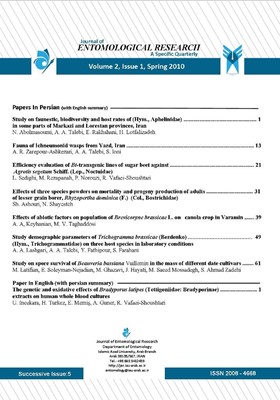-
-
List of Articles
-
Open Access Article
1 - Study on faunistic, biodiversity and host rates of (Hym., Aphelinidae) in some parts of Markazi and Lorestan provinces, Iran
N. Abolmasoumi A. A. Talebi E. Rakhshani H. Lotfalizadeh -
Open Access Article
2 - Fauna of Ichneumonid wasps from Yazd, Iran
A. R. Zarepour-Ashkezari A. A. Talebi S. loni -
Open Access Article
3 - Efficiency evaluation of Bt-transgenic lines of sugar beet against Agrotis segetum Schiff. (Lep., Noctuidae)
L. Sedighi M. Rezapanah P. Norouzi R. Vafaei-Shoushtari -
Open Access Article
4 - Effects of three spices powders on mortality and progeny of adults of lesser grain borer, Rhyzopertha dominica (F.) (Col., Bostrichidae)
Sh. Ashouri N. Shayesteh -
Open Access Article
5 - Effects of abiotic factors on population of Brevicoryne brassicae L. on canola crop in Varamin
A. A. Keyhanian M. V. Taghaddosi -
Open Access Article
6 - Study on demographic parameters of Trichogramma brassicae (Bezdenko) (Hym., Trichogrammatidae) on three host species in laboratory conditions
A. A. Lashgari A. A. Talebi Y. Fathipour S. Farahani -
Open Access Article
7 - Study on spore survival of Beauveria bassiana Vuillemin in the mass of different date cultivars
M. Latifian E. Soleyman-Nejadian M. Ghazavi J. Hayati M. S. Mossadegh S. Ahmadi Zadeh
-
The rights to this website are owned by the Raimag Press Management System.
Copyright © 2021-2025







